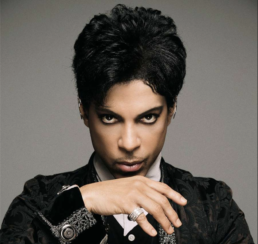These life stories may contain descriptions of childhood trauma and abuse, as well as images, voices and names of people now deceased. If you need help, you can find contact details for some relevant support services on our support page.
Prolific African American singer and songwriter, Prince (1958-2016), was in foster care as a teenager.
Prince Rogers Nelson was born in Minneapolis to jazz musician, John Nelson, and jazz singer, Mattie Shaw. John Nelson headed up the Prince Rogers jazz trio and Mattie was vocalist for the trio, but left the group after she married. Mattie and John named their son Prince after the trio although he was more often known as ‘Skipper’ when he was growing up.
Prince’s parents separated when he was about ten years old. From then he alternated living with both, even after his mother remarried. Hayward Baker, Prince’s stepfather, took the boy to see James Brown, an important influence on the boy’s songwriting and performing.
Prince became good friends with Andre Anderson (to become known as Andre Cymone), a newcomer to Prince’s school at around age twelve. After Prince became tired of moving between his mother’s and his father’s house, he moved in with Andre and his family.
In the end he ran away. I get a knock on the door and he’s there: ‘Man, can I come and stay with you guys?’. I said ‘Yeah, it’d be great, but you’ll have to talk to my mom.’ So my mom talked to his mom, and she said yeah. I think they thought it would only be temporary but it wound up being six or seven years (Price).
Prince was still in his teens when he signed a recording contract with Warner Bros. His second album, Prince (1979), sold more than a million copies.
…for the next two decades Prince albums never failed to reach the Top 100. During the 1980s, nearly all were million-sellers that reached the Top 10 (Pareles).
During the 1980s, Prince was often seen as a “crossover artist” where “crossover” means an artist with appeal to a broad audience. By the early 2000s, he was a “living legend,” continuing to record as well as perform live.
In 2007, he headlined the Super Bowl halftime show, performing a nearly 20-minute set that Dave Hoekstra described in the Chicago Sun-Times as “a mixture of adventure, innovation and even a dash of innocence.” The performance reached some 140 million television viewers and raised the halftime show’s reputation for showcasing mega-popular music acts (Mellors).
Prince was inducted into the Rock and Roll Hall of Fame in 2004 and was a seven-time Grammy winner.
In a statement on Prince’s death in 2016, President Obama said:
“Few artists have influenced the sound and trajectory of popular music more distinctly, or touched quite so many people with their talent…He was a virtuoso instrumentalist, a brilliant bandleader, and an electrifying performer. ‘A strong spirit transcends rules,’ Prince once said — and nobody’s spirit was stronger, bolder, or more creative” (Pareles).
References:
Mellors, Julie. “Prince.” Encyclopedia of World Biography, vol. 38 (2018).
Pareles, Jon. “Prince, an Artist Who Defied Genre, Is Dead at 57.” The New York Times, 21 April 2016. https://www.nytimes.com/2016/04/22/arts/music/prince-dead.html
Price, Simon. “Remembering Prince: Andrew Cymone Interviewed.” The Quietus.Com, 2018. https://thequietus.com/articles/24432-andre-cymone-interview-prince
Sweeting, Adam. “Prince obituary.” The Guardian, 23 April 2016. https://www.theguardian.com/music/2016/apr/22/prince-obituary
Vogel, Joseph. This Thing Called Life: Prince, Race, Sex, Religion, and Music. New York: Bloomsbury Academic & Professional.
Image available here.
